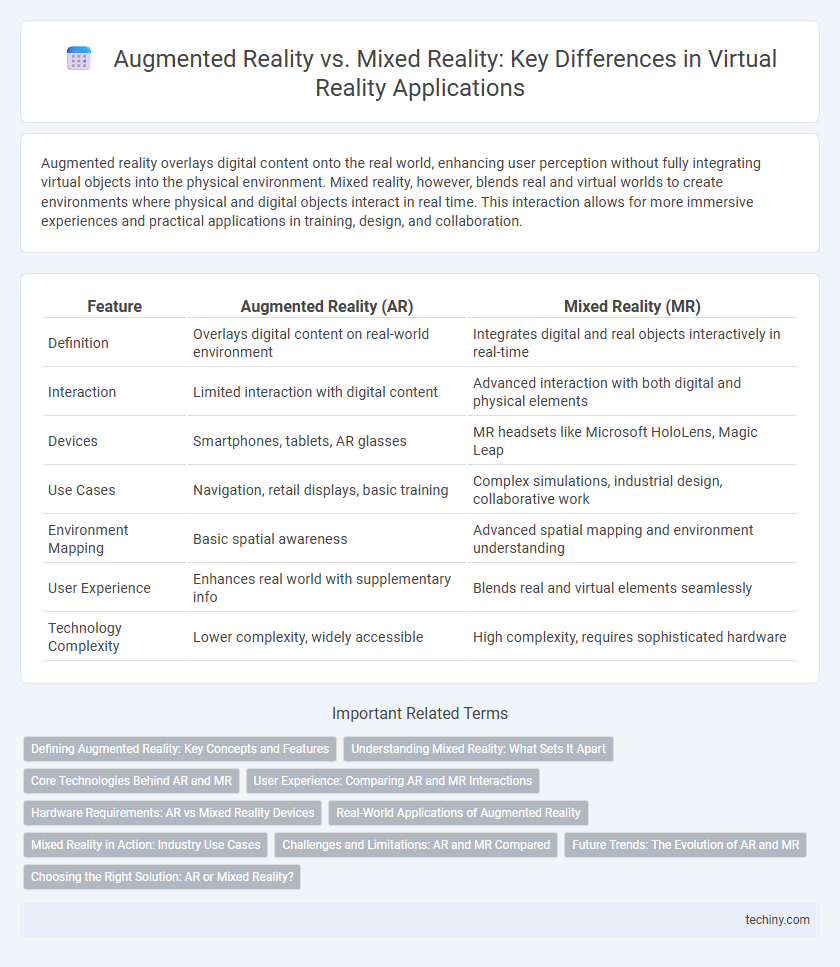Augmented reality overlays digital content onto the real world, enhancing user perception without fully integrating virtual objects into the physical environment. Mixed reality, however, blends real and virtual worlds to create environments where physical and digital objects interact in real time. This interaction allows for more immersive experiences and practical applications in training, design, and collaboration.
Table of Comparison
| Feature | Augmented Reality (AR) | Mixed Reality (MR) |
|---|---|---|
| Definition | Overlays digital content on real-world environment | Integrates digital and real objects interactively in real-time |
| Interaction | Limited interaction with digital content | Advanced interaction with both digital and physical elements |
| Devices | Smartphones, tablets, AR glasses | MR headsets like Microsoft HoloLens, Magic Leap |
| Use Cases | Navigation, retail displays, basic training | Complex simulations, industrial design, collaborative work |
| Environment Mapping | Basic spatial awareness | Advanced spatial mapping and environment understanding |
| User Experience | Enhances real world with supplementary info | Blends real and virtual elements seamlessly |
| Technology Complexity | Lower complexity, widely accessible | High complexity, requires sophisticated hardware |
Defining Augmented Reality: Key Concepts and Features
Augmented Reality (AR) superimposes digital elements onto the real-world environment, enhancing user perception through devices like smartphones or AR glasses. It integrates computer-generated images, sounds, and data with physical surroundings, maintaining the real world as the primary focus. Key features include real-time interaction, spatial mapping, and contextual awareness, differentiating AR from Mixed Reality, which blends and anchors virtual objects more seamlessly within the physical space.
Understanding Mixed Reality: What Sets It Apart
Mixed reality (MR) merges real and virtual environments to create interactive experiences where digital objects coexist and interact with the physical world, unlike augmented reality (AR), which overlays digital elements without full integration. MR uses advanced sensors and spatial mapping technologies to enable real-time interaction and precise alignment of virtual content with the real environment. This seamless blending enhances user immersion and functionality, distinguishing MR as a hybrid technology beyond the visual augmentations of AR.
Core Technologies Behind AR and MR
Augmented Reality (AR) primarily relies on computer vision, simultaneous localization and mapping (SLAM), and depth tracking to overlay digital content onto the real world, enhancing the user's perception without altering the environment itself. Mixed Reality (MR) integrates AR technologies with spatial mapping, advanced sensors, and real-time environmental interaction, allowing digital objects to be anchored and interacted with in a more immersive and context-aware manner. Both AR and MR utilize display technologies like head-mounted displays (HMDs) and leveraging cloud computing for processing power, but MR demands higher precision in spatial awareness and environmental integration to blend virtual and physical elements seamlessly.
User Experience: Comparing AR and MR Interactions
Augmented Reality (AR) enhances real-world environments by overlaying digital content, enabling users to interact with virtual objects without losing sight of their physical surroundings. Mixed Reality (MR) merges real and virtual worlds more seamlessly, allowing users to manipulate digital elements anchored in the real environment for a more immersive and context-aware experience. MR interactions typically offer higher spatial awareness and precision, resulting in improved user engagement and task performance compared to standard AR applications.
Hardware Requirements: AR vs Mixed Reality Devices
Augmented reality (AR) devices typically require less complex hardware, such as smartphones or simple headsets equipped with cameras and sensors to overlay digital content on the real world. Mixed reality (MR) devices demand advanced hardware, including depth sensors, spatial mapping technologies, and powerful processors to seamlessly blend digital and physical environments. High-end MR headsets like Microsoft HoloLens and Magic Leap feature integrated sensors and computing units to enable interactive and immersive user experiences beyond conventional AR capabilities.
Real-World Applications of Augmented Reality
Augmented reality (AR) enhances real-world environments by overlaying digital information, widely used in industries such as retail, healthcare, and manufacturing to improve user experience and operational efficiency. AR applications enable interactive product visualization, remote assistance, and real-time data access, boosting productivity and customer engagement. These real-world implementations highlight AR's ability to seamlessly integrate virtual elements without fully immersing users, differentiating it from mixed reality (MR), which blends physical and digital worlds more extensively.
Mixed Reality in Action: Industry Use Cases
Mixed reality (MR) blends real and virtual environments to create interactive experiences used extensively in manufacturing, healthcare, and education. In industrial settings, MR enhances training by allowing workers to visualize complex machinery and perform hands-on tasks safely through holographic overlays. Healthcare professionals use MR for precise surgical planning and augmented diagnostics, improving patient outcomes with real-time data integration.
Challenges and Limitations: AR and MR Compared
Augmented reality (AR) faces challenges in limited field of view and spatial occlusion, restricting seamless integration of virtual objects with the real environment. Mixed reality (MR) requires advanced sensors and accurate environmental mapping, which increases hardware cost and complexity, often leading to latency issues. Both AR and MR struggle with varying lighting conditions and user ergonomics that impact long-term usability and immersion quality.
Future Trends: The Evolution of AR and MR
Future trends in augmented reality (AR) and mixed reality (MR) emphasize deeper integration with AI-driven environments and enhanced spatial computing capabilities, enabling more immersive, context-aware experiences. Advancements in lightweight wearable devices and improved sensor accuracy will drive broader adoption across industries such as healthcare, education, and manufacturing. The evolution of AR and MR is expected to blur the boundaries between digital and physical spaces, fostering seamless interaction and collaboration in both virtual and real-world scenarios.
Choosing the Right Solution: AR or Mixed Reality?
Choosing the right solution between augmented reality (AR) and mixed reality (MR) depends on the level of interaction and immersion required. AR overlays digital content onto the real world, enhancing the environment without full integration, ideal for applications like navigation and retail. MR blends physical and digital objects in real time, enabling more complex interactions suited for training, design, and collaboration scenarios.
augmented reality vs mixed reality Infographic

 techiny.com
techiny.com